The Multiple Reaction Monitoring Assay Market is estimated to be valued at USD 1.7 billion in 2025 and is projected to reach USD 2.9 billion by 2035, registering a compound annual growth rate (CAGR) of 5.7% over the forecast period.
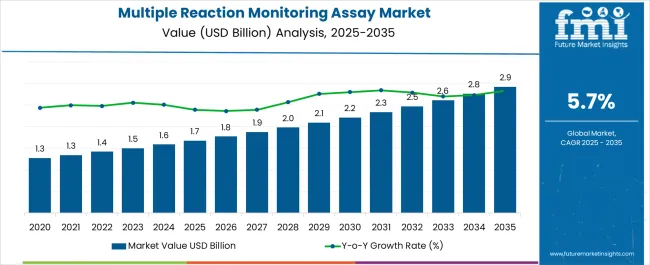
| Metric | Value |
|---|---|
| Multiple Reaction Monitoring Assay Market Estimated Value in (2025 E) | USD 1.7 billion |
| Multiple Reaction Monitoring Assay Market Forecast Value in (2035 F) | USD 2.9 billion |
| Forecast CAGR (2025 to 2035) | 5.7% |
The multiple reaction monitoring assay market is witnessing steady growth, supported by its increasing application in clinical research, proteomics, and precision medicine. The ability of MRM assays to deliver highly sensitive and specific quantification of target proteins is reinforcing their adoption across life sciences. Growing investments in biomarker discovery and validation, coupled with the rising demand for reproducible and scalable analytical tools, are shaping the future trajectory of the market.
Advancements in mass spectrometry platforms and automation technologies are further enhancing assay accuracy and throughput, making them increasingly attractive for complex biological analysis. Pharmaceutical and biotechnology companies are expanding the use of MRM assays for drug development and clinical validation, strengthening the market outlook.
Regulatory focus on biomarker-driven diagnostics and the demand for robust data in translational research are adding further momentum As healthcare systems worldwide prioritize personalized and data-driven treatment strategies, MRM assays are expected to play a central role in supporting diagnostic accuracy and therapeutic advancements, creating strong growth opportunities for the market in the coming years.
The multiple reaction monitoring assay market is segmented by assay type, usage, end user type, and geographic regions. By assay type, multiple reaction monitoring assay market is divided into Custom MRM assays, Human discovery assay, Human cardiovascular MRM assay, and Human cancer MRM assay. In terms of usage, multiple reaction monitoring assay market is classified into Biomarker assessment, MRM-MS quality control, Platform performance, and Workflow performance. Based on end user type, multiple reaction monitoring assay market is segmented into Research institutes, Hospitals, and Diagnostic centers. Regionally, the multiple reaction monitoring assay industry is classified into North America, Latin America, Western Europe, Eastern Europe, Balkan & Baltic Countries, Russia & Belarus, Central Asia, East Asia, South Asia & Pacific, and the Middle East & Africa.
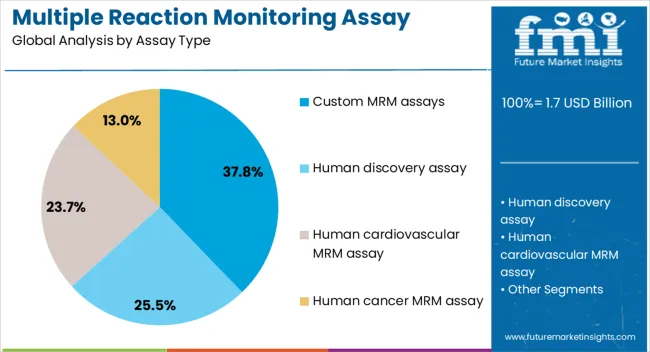
The custom MRM assays segment is projected to hold 37.8% of the multiple reaction monitoring assay market revenue share in 2025, making it the leading assay type. Its dominance is being reinforced by the flexibility it offers in tailoring assays to specific research requirements, enabling precise detection of unique biomarkers. Researchers and clinicians are increasingly turning to custom assays to address unmet needs in disease-specific studies and translational research where standardized solutions may not provide sufficient sensitivity.
The ability to design assays that accommodate different protein targets, pathways, and biological conditions is providing significant advantages in both preclinical and clinical settings. This segment is also benefiting from rising pharmaceutical investment in personalized drug development, where customized biomarker measurement plays a pivotal role.
Technological advancements in assay design platforms and analytical instrumentation are supporting rapid development and validation, further enhancing utility As demand for specialized and targeted research solutions grows, the custom assay segment is expected to maintain leadership, driven by its adaptability and alignment with evolving clinical and research priorities.
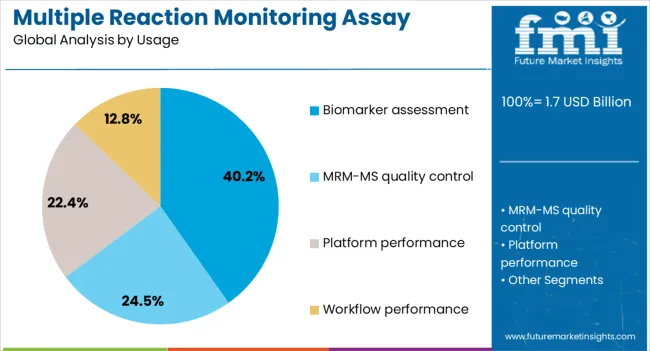
The biomarker assessment segment is anticipated to account for 40.2% of the multiple reaction monitoring assay market revenue share in 2025, making it the leading usage area. Growth in this segment is being driven by the expanding role of biomarkers in disease diagnosis, treatment monitoring, and drug development. The ability of MRM assays to provide highly reproducible and quantitative data is enabling researchers to validate biomarkers with greater precision, supporting clinical decision-making and accelerating translational studies.
Pharmaceutical companies are increasingly incorporating biomarker assessment into their development pipelines to identify patient-specific responses and improve therapeutic outcomes. Rising emphasis on personalized medicine and early disease detection is further enhancing the importance of robust biomarker measurement technologies.
Continuous progress in mass spectrometry, coupled with improvements in sample preparation techniques, is boosting assay performance, ensuring accuracy even in complex biological matrices With regulatory bodies highlighting the importance of validated biomarkers in clinical applications, this segment is positioned to sustain leadership, reflecting its central role in modern healthcare research and innovation.
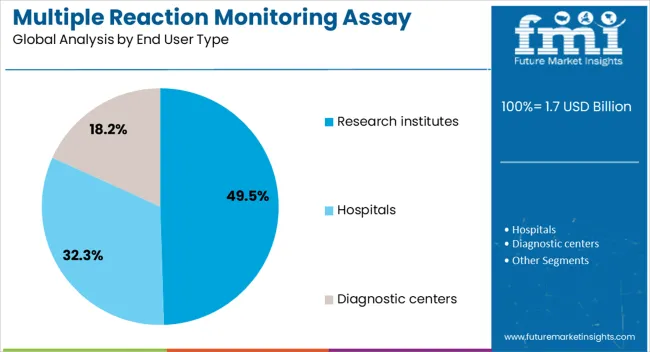
The research institutes segment is expected to capture 49.5% of the multiple reaction monitoring assay market revenue share in 2025, establishing itself as the leading end-user category. This dominance is being reinforced by the growing demand for reliable and high-throughput analytical tools in academic and institutional research programs. MRM assays are increasingly being adopted by research institutes for biomarker discovery, disease pathway analysis, and validation of translational studies, given their proven accuracy and reproducibility.
The segment is benefiting from rising government and institutional funding for life sciences research, particularly in proteomics and genomics. The ability of research institutes to integrate MRM assays into large-scale studies is strengthening their contribution to knowledge creation and clinical innovation.
Additionally, collaborations between research institutes and pharmaceutical companies are expanding the use of these assays in preclinical and early-stage clinical development As global research networks continue to prioritize biomarker-driven science and precision healthcare, research institutes are expected to remain the largest consumer group, driving innovation and supporting long-term market expansion.
Multiple reaction monitoring (MRM) is a technique used to detect proteins and peptides in biological samples. The technique is being used for many years for the detection of small molecules in clinical samples. The traditional mass spectrometric approach detects all the proteins in the sample while MRM approach provides greater selectivity and allows the researcher to calibrate or adjust the instrument to specifically detect protein of interest.
Multiple reaction monitoring assay approach gives better sensitivity, specificity, and speed of detection in wide range of analyte concentration. MRM is coupled with a mass spectrometry technique.
The global multiple reaction monitoring assay market is expected to grow moderately due to increasing research and development activities in the biologics field. However, the designing and running of MRM assays is a time consuming process and also demands resources in terms of capital and manpower which can act as a major restraint for the global multiple reaction monitoring assay market.
Multiple reaction monitoring assays are mainly performed in the research institutes and diagnostic centers to quantify the biomarkers in the biological samples or to monitor the progress of a disease and treatment. Peptides containing 7-17 amino acids are the best candidates for multiple reaction monitoring assay.
Region wise, the global multiple reaction monitoring assay market is classified into regions namely, North America, Latin America, Western Europe, Eastern Europe, Asia-Pacific, Japan, Middle East and Africa.Western Europe countries such as France, Germany, UK and Italy are expected to contribute major market share in the global multiple reaction monitoring assay market due to higher number of installed systems and biology research institutes in the region followed by North America.
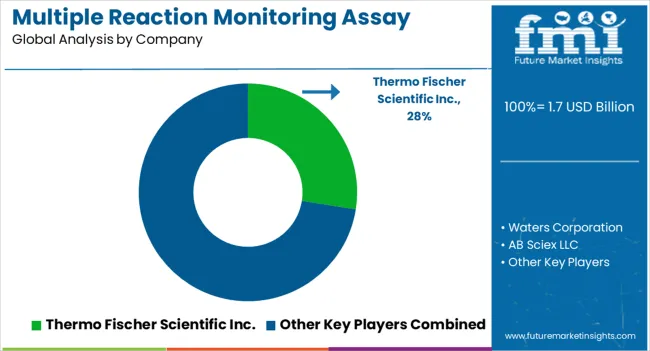
Some of the key players in global antibodies market are MRM Proteomics, Thermo Fisher Scientific, Sigma Aldrich, etc.
The report is a compilation of first-hand information, qualitative and quantitative assessment by industry analysts, inputs from industry experts and industry participants across the value chain. The report provides in-depth analysis of parent market trends, macro-economic indicators and governing factors along with market attractiveness as per segments. The report also maps the qualitative impact of various market factors on market segments and geographies.
| Country | CAGR |
|---|---|
| China | 16.2% |
| India | 15.0% |
| Germany | 13.8% |
| France | 12.6% |
| UK | 11.4% |
| USA | 10.2% |
| Brazil | 9.0% |
The Multiple Reaction Monitoring Assay Market is expected to register a CAGR of 5.7% during the forecast period, exhibiting varied country level momentum. China leads with the highest CAGR of 16.2%, followed by India at 15.0%. Developed markets such as Germany, France, and the UK continue to expand steadily, while the USA is likely to grow at consistent rates. Brazil posts the lowest CAGR at 4.3%, yet still underscores a broadly positive trajectory for the global Multiple Reaction Monitoring Assay Market. In 2024, Germany held a dominant revenue in the Western Europe market and is expected to grow with a CAGR of 6.6%. The USA Multiple Reaction Monitoring Assay Market is estimated to be valued at USD 602.6 million in 2025 and is anticipated to reach a valuation of USD 967.2 million by 2035. Sales are projected to rise at a CAGR of 4.8% over the forecast period between 2025 and 2035. While Japan and South Korea markets are estimated to be valued at USD 83.2 million and USD 53.7 million respectively in 2025.
| Item | Value |
|---|---|
| Quantitative Units | USD 1.7 Billion |
| Assay Type | Custom MRM assays, Human discovery assay, Human cardiovascular MRM assay, and Human cancer MRM assay |
| Usage | Biomarker assessment, MRM-MS quality control, Platform performance, and Workflow performance |
| End User Type | Research institutes, Hospitals, and Diagnostic centers |
| Regions Covered | North America, Europe, Asia-Pacific, Latin America, Middle East & Africa |
| Country Covered | United States, Canada, Germany, France, United Kingdom, China, Japan, India, Brazil, South Africa |
| Key Companies Profiled | Thermo Fischer Scientific Inc., Waters Corporation, AB Sciex LLC, Agilent Technologies, Inc., and Merck KGaA |
The global multiple reaction monitoring assay market is estimated to be valued at USD 1.7 billion in 2025.
The market size for the multiple reaction monitoring assay market is projected to reach USD 2.9 billion by 2035.
The multiple reaction monitoring assay market is expected to grow at a 5.7% CAGR between 2025 and 2035.
The key product types in multiple reaction monitoring assay market are custom mrm assays, human discovery assay, human cardiovascular mrm assay and human cancer mrm assay.
In terms of usage, biomarker assessment segment to command 40.2% share in the multiple reaction monitoring assay market in 2025.






Our Research Products

The "Full Research Suite" delivers actionable market intel, deep dives on markets or technologies, so clients act faster, cut risk, and unlock growth.

The Leaderboard benchmarks and ranks top vendors, classifying them as Established Leaders, Leading Challengers, or Disruptors & Challengers.

Locates where complements amplify value and substitutes erode it, forecasting net impact by horizon

We deliver granular, decision-grade intel: market sizing, 5-year forecasts, pricing, adoption, usage, revenue, and operational KPIs—plus competitor tracking, regulation, and value chains—across 60 countries broadly.

Spot the shifts before they hit your P&L. We track inflection points, adoption curves, pricing moves, and ecosystem plays to show where demand is heading, why it is changing, and what to do next across high-growth markets and disruptive tech

Real-time reads of user behavior. We track shifting priorities, perceptions of today’s and next-gen services, and provider experience, then pace how fast tech moves from trial to adoption, blending buyer, consumer, and channel inputs with social signals (#WhySwitch, #UX).

Partner with our analyst team to build a custom report designed around your business priorities. From analysing market trends to assessing competitors or crafting bespoke datasets, we tailor insights to your needs.
Supplier Intelligence
Discovery & Profiling
Capacity & Footprint
Performance & Risk
Compliance & Governance
Commercial Readiness
Who Supplies Whom
Scorecards & Shortlists
Playbooks & Docs
Category Intelligence
Definition & Scope
Demand & Use Cases
Cost Drivers
Market Structure
Supply Chain Map
Trade & Policy
Operating Norms
Deliverables
Buyer Intelligence
Account Basics
Spend & Scope
Procurement Model
Vendor Requirements
Terms & Policies
Entry Strategy
Pain Points & Triggers
Outputs
Pricing Analysis
Benchmarks
Trends
Should-Cost
Indexation
Landed Cost
Commercial Terms
Deliverables
Brand Analysis
Positioning & Value Prop
Share & Presence
Customer Evidence
Go-to-Market
Digital & Reputation
Compliance & Trust
KPIs & Gaps
Outputs
Full Research Suite comprises of:
Market outlook & trends analysis
Interviews & case studies
Strategic recommendations
Vendor profiles & capabilities analysis
5-year forecasts
8 regions and 60+ country-level data splits
Market segment data splits
12 months of continuous data updates
DELIVERED AS:
PDF EXCEL ONLINE
Multiplex Sepsis Biomarker Panels Market Size and Share Forecast Outlook 2025 to 2035
Multiplex Protein Profiling Market Size and Share Forecast Outlook 2025 to 2035
Multiplex Biomarker Imaging Market Forecast and Outlook 2025 to 2035
Multiplex Molecular Diagnostics Market Size and Share Forecast Outlook 2025 to 2035
Multiple System Atrophy (MSA) Therapeutics Market Size and Share Forecast Outlook 2025 to 2035
MUPS Market Overview - Growth & Forecast 2025 to 2035
Multiple Myeloma Diagnostics Market
Multiple Endocrine Neoplasia Market
Multiplex Assay Market
Multiplex PCR Assays Market Size and Share Forecast Outlook 2025 to 2035
Syndromic Multiplex Diagnostic Market
Wavelength Division Multiplexing (WDM) Equipment Market Analysis - Size, Growth, and Forecast 2025 to 2035
Real-Time PCR Systems Market Growth – Trends & Forecast 2025 to 2035
Immunoassay Market Size and Share Forecast Outlook 2025 to 2035
Immunoassay CDMO Market Analysis – Size, Trends & Industry Outlook 2025-2035
Custom Assays Market
Lactose Assay Kit Market Size and Share Forecast Outlook 2025 to 2035
Diabetic Assays Market
ELISA POT Assay Kits Market Size and Share Forecast Outlook 2025 to 2035
Crude Oil Assay Testing Services Market

Thank you!
You will receive an email from our Business Development Manager. Please be sure to check your SPAM/JUNK folder too.
Chat With
MaRIA